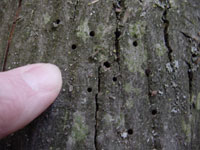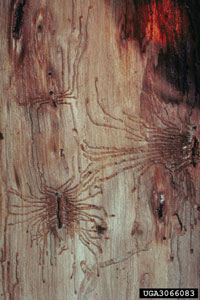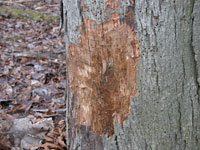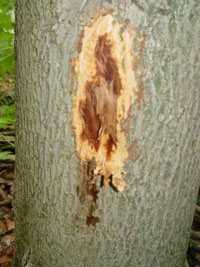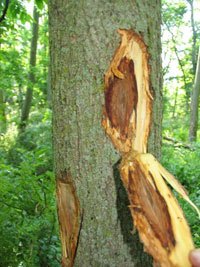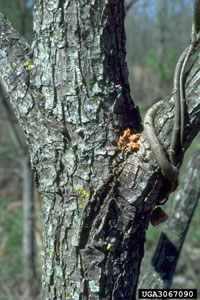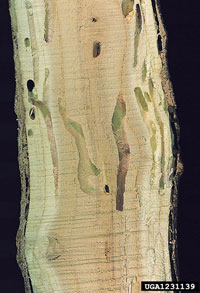Extension > Garden > Diagnose a problem > What's wrong with my plant? > Deciduous Trees > Hickory > Holes in trunk or branches
Hickory > Trunk/Branches > Holes in trunk or branches
1 of 4
Hickory bark beetle
Scolytus quadrispinosus
- Small, 1/8th inch, round exit holes in trunk and branches
- Heavily infested trees typically have sparse, yellowed leaves
- Premature leaf drop and broken twigs in crown can also occur when heavily infested
- Weakened, stressed trees most likely attacked, rarely infest healthy trees
- High Hickory bark beetle populations are often associated with Hickory decline
- Adults dark brown to black, less than ¼ inch long
- More information on Hickory bark beetle
2 of 4
Hickory decline
Ceratocystis smalleyi and
Scolytus quadrispinosus
- Leaves are wilted or undersized, thin canopy with dead branches
- When bark is peeled back, numerous reddish brown oval cankers up to 1 ft. long can be seen
- Bark surface often shows no symptoms, occasionally cracking or dark sunken area can be seen
- Dark bleeding spots that appear in May or June indicate cankers below the bark
- Groups of young green shoots (sprouts) often form along the trunk; these wilt and die within a year
- Round 1/8th inch exit holes of hickory bark beetles on upper trunk
- Larval galleries often visible in discolored sapwood
- Trees can decline and die in as little as two years when beetle populations are high
- More information on Hickory decline
3 of 4
Yellow bellied sapsucker
Sphyrapicus varius
- Evenly spaced holes in main stem, approximately ¼ inch, arranged in a linear or columnar pattern
- Repetitive tapping or drumming heard
- Birds with black and white patterns, often some with red, seen tapping on trees
- More information on Yellow bellied sapsucker
4 of 4
Longhorned beetles
Redheaded ash borer, Neoclytus acuminatus, and Living-hickory borer, Goes pulcher
- Entrance holes at branch crotches can ooze sap and frass
- Exit holes, 1/4 - 3/8 inch wide, first appear in June
- Galleries start in phloem and eventually enter into sapwood; generally not very serpentine
- Larvae are 3/4 to 1 inch long, cylindrical shaped bodies
- More information on Longhorned beetles



